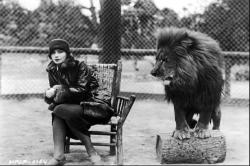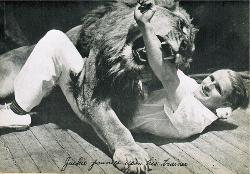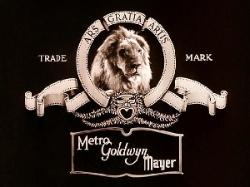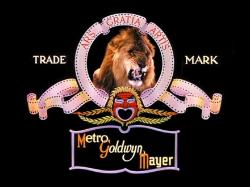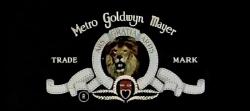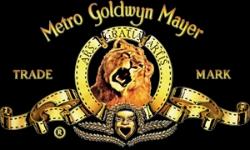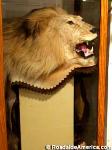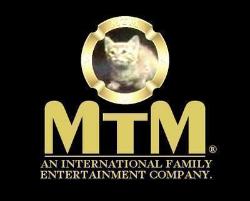| http://en.wikipedia.org/wiki/MTM_Enterprises |
| XXX |
| XXX |
| MGM's short-lived stylized logo. |
The logo was first designed for Goldwyn Pictures Corporation, in 1916 by the
Paramount Studios art director Lionel S. Reiss. Howard Deitz, a Publicity Executive,
chose to use a lion as the studio’smascot, paying tribute to his alma mater, Columbia
University. The inspiration was the school’s fight song “Roar, Lion, Roar”. Mr. Deitz is
also credited for writing our motto “Ars Gratia Artis”, Latin meaning “Art for Art’s
Sake”. “Slats” was the first lion used on Goldwyn Pictures logo from 1917 until 1924,
first appearing on the 1917 release “Polly of the Circus”.
Since 1924 (when the studio was formed by the merger of Samuel Goldwyn's studio
with Marcus Loew's Metro Pictures and Louis B. Mayer's company), there have been
around five different lions used for the MGM logo (although two other lions were used
for MGM's two-strip Technicolor films in the late 1920s and early '30s). These lions
include Tanner, and Leo, the current (and officially seventh) lion. Tanner was used on
all Technicolor films and MGM cartoons (including the Tom and Jerry series),
and in use on the studio logo for 22 years (Leo has been in use since 1957, a total of 56
years and counting). However, when the MGM animation department, which had
closed in 1958, reopened with the Chuck Jones-directed Tom and Jerry shorts in 1963,
these shorts used Tanner in the opening sequence rather than Leo, who had already
been adapted onto the studio logo and the Gene Deitch-directed Tom and Jerry
cartoons from 1960-62.
“Leo’s” voice, which was one of the first logo sound tracks to actually be trade
marked. And to this day is still one of the most recognized logo sounds, perhaps second
only to the NBC Chimes. In 1982 the studio was producing “Poltergeist”, at which time
“Leo’s” roar was still only a mono audio track. Mark Mangini, a member of the sound
crew, had recorded animal sounds, including lions, for use in the film itself. These raw
elements were altered to create the creature sound effects in the film.
However while working on the mix, Mark asked Steven Spielberg, if he would like to
use the stereo lion sounds he recorded in order to make a new roar for the logo. Steven
gave the OK and upon the release of the film, “Leo” was now being heard in stereo. In
1995, Mark was brought back and utilizing the same audio elements used from 1982,
re-created “Leo’s” roar in 5.1 surround sound.
Paramount Studios art director Lionel S. Reiss. Howard Deitz, a Publicity Executive,
chose to use a lion as the studio’smascot, paying tribute to his alma mater, Columbia
University. The inspiration was the school’s fight song “Roar, Lion, Roar”. Mr. Deitz is
also credited for writing our motto “Ars Gratia Artis”, Latin meaning “Art for Art’s
Sake”. “Slats” was the first lion used on Goldwyn Pictures logo from 1917 until 1924,
first appearing on the 1917 release “Polly of the Circus”.
Since 1924 (when the studio was formed by the merger of Samuel Goldwyn's studio
with Marcus Loew's Metro Pictures and Louis B. Mayer's company), there have been
around five different lions used for the MGM logo (although two other lions were used
for MGM's two-strip Technicolor films in the late 1920s and early '30s). These lions
include Tanner, and Leo, the current (and officially seventh) lion. Tanner was used on
all Technicolor films and MGM cartoons (including the Tom and Jerry series),
and in use on the studio logo for 22 years (Leo has been in use since 1957, a total of 56
years and counting). However, when the MGM animation department, which had
closed in 1958, reopened with the Chuck Jones-directed Tom and Jerry shorts in 1963,
these shorts used Tanner in the opening sequence rather than Leo, who had already
been adapted onto the studio logo and the Gene Deitch-directed Tom and Jerry
cartoons from 1960-62.
“Leo’s” voice, which was one of the first logo sound tracks to actually be trade
marked. And to this day is still one of the most recognized logo sounds, perhaps second
only to the NBC Chimes. In 1982 the studio was producing “Poltergeist”, at which time
“Leo’s” roar was still only a mono audio track. Mark Mangini, a member of the sound
crew, had recorded animal sounds, including lions, for use in the film itself. These raw
elements were altered to create the creature sound effects in the film.
However while working on the mix, Mark asked Steven Spielberg, if he would like to
use the stereo lion sounds he recorded in order to make a new roar for the logo. Steven
gave the OK and upon the release of the film, “Leo” was now being heard in stereo. In
1995, Mark was brought back and utilizing the same audio elements used from 1982,
re-created “Leo’s” roar in 5.1 surround sound.
films, the most well known is “2001: A Space Odyssey” in 1968.
No one is really sure if the lion purchased from Henry Treffich, an animal importer and
dealer, was actually named “Leo”. However, that was the name that stuck, “Leo The
Lion”.
In addition to being used as the MGM lion, Leo also appeared in Tarzan movies starring
Mike Henry and the television series that starred Ron Ely, in addition to other
productions such as the religious epic King of Kings (1961), Zebra in the Kitchen
(1965), Fluffy (1965) and Napoleon and Samantha (1972); as well as a memorable TV
commercial for Dreyfus Investments in 1966.
Two different versions of this logo were used: an "extended" version, with the lion
roaring three times with extra head glances (used from 1957–1960), and the "standard"
version, with the lion roaring twice (used since 1960). However, in the Chuck Jones-
directed Tom and Jerry cartoons released between 1963 and 1967, Tanner was used in
the opening sequence instead of Leo. Three MGM films, Raintree County (1957), Ben-
Hur (1959), and Mutiny on the Bounty (1962), utilized a still-frame variation of this
logo, with the lion's roar added to the backing track. (Ben-Hur, however, did not
include the roar; instead, the film score continued underneath the still-frame of the
logo). This logo would also appear on black-and-white films, such as Jailhouse Rock
(1957).
No one is really sure if the lion purchased from Henry Treffich, an animal importer and
dealer, was actually named “Leo”. However, that was the name that stuck, “Leo The
Lion”.
In addition to being used as the MGM lion, Leo also appeared in Tarzan movies starring
Mike Henry and the television series that starred Ron Ely, in addition to other
productions such as the religious epic King of Kings (1961), Zebra in the Kitchen
(1965), Fluffy (1965) and Napoleon and Samantha (1972); as well as a memorable TV
commercial for Dreyfus Investments in 1966.
Two different versions of this logo were used: an "extended" version, with the lion
roaring three times with extra head glances (used from 1957–1960), and the "standard"
version, with the lion roaring twice (used since 1960). However, in the Chuck Jones-
directed Tom and Jerry cartoons released between 1963 and 1967, Tanner was used in
the opening sequence instead of Leo. Three MGM films, Raintree County (1957), Ben-
Hur (1959), and Mutiny on the Bounty (1962), utilized a still-frame variation of this
logo, with the lion's roar added to the backing track. (Ben-Hur, however, did not
include the roar; instead, the film score continued underneath the still-frame of the
logo). This logo would also appear on black-and-white films, such as Jailhouse Rock
(1957).
appear on three earlier films, “Greed” (1924), “Ben Hur” (1925) and “Flesh and the
Devil” (1926). The most famous MGM title he appeared on was “The Wizard Of Oz” in
1939.
However that was not to be “Jackie’s” most significant contribution to history. He was
the first of our lions to be heard by an audience, via a gramophone recording, on July
31, 1928 on “White Shadow Of The Seven Seas”, the first sounded MGM production..
Jackie growled softly; this was followed by a louder roar, a brief pause, and then a final
growl, before he looked off to the right of the screen. In the early years that this logo
was used (1928–c.1932), there was a slightly extended version of the logo wherein,
after roaring, the lion looked off to the right and returned his gaze to the front seconds
later. Jackie appeared on all black-and-white MGM films from 1928–1956, as well as
the sepia-tinted opening credits of The Wizard of Oz (1939).
He also appeared before MGM's black-and-white cartoons, such as the Flip the Frog
and Willie Whopper series produced for MGM by the short-lived Ub Iwerks Studio, as
well as the Captain and the Kids cartoons produced by MGM in 1938 and 1939. A
colorized variation of the logo can be found on the colorized version of Babes in
Toyland (1934), also known as March of the Wooden Soldiers; an animated version
(done via rotoscope) appeared on the 1939 Captain and the Kids cartoon Petunia
Natural Park. Jackie died on February 26, 1952. He would later make a comeback in
Devil” (1926). The most famous MGM title he appeared on was “The Wizard Of Oz” in
1939.
However that was not to be “Jackie’s” most significant contribution to history. He was
the first of our lions to be heard by an audience, via a gramophone recording, on July
31, 1928 on “White Shadow Of The Seven Seas”, the first sounded MGM production..
Jackie growled softly; this was followed by a louder roar, a brief pause, and then a final
growl, before he looked off to the right of the screen. In the early years that this logo
was used (1928–c.1932), there was a slightly extended version of the logo wherein,
after roaring, the lion looked off to the right and returned his gaze to the front seconds
later. Jackie appeared on all black-and-white MGM films from 1928–1956, as well as
the sepia-tinted opening credits of The Wizard of Oz (1939).
He also appeared before MGM's black-and-white cartoons, such as the Flip the Frog
and Willie Whopper series produced for MGM by the short-lived Ub Iwerks Studio, as
well as the Captain and the Kids cartoons produced by MGM in 1938 and 1939. A
colorized variation of the logo can be found on the colorized version of Babes in
Toyland (1934), also known as March of the Wooden Soldiers; an animated version
(done via rotoscope) appeared on the 1939 Captain and the Kids cartoon Petunia
Natural Park. Jackie died on February 26, 1952. He would later make a comeback in
Jackie was the second lion used for the
MGM logo. He was selected because he
was a look a like for “Slats”. “Jackie”
was born circa 1915 and was captured
as a cub in the Nubian dessert. He spent
much of his life in Hollywood as a
performer in jungle pictures, eventually
chosen to appear on the MGM logo.
It is believed that it is “Jackie” in the
photograph of a lion being filmed and
recorded hanging in the halls of MGM.
Before his official introduction he did
MGM logo. He was selected because he
was a look a like for “Slats”. “Jackie”
was born circa 1915 and was captured
as a cub in the Nubian dessert. He spent
much of his life in Hollywood as a
performer in jungle pictures, eventually
chosen to appear on the MGM logo.
It is believed that it is “Jackie” in the
photograph of a lion being filmed and
recorded hanging in the halls of MGM.
Before his official introduction he did
| XXX |
| XXX |
| XXXXX |
| ********** |
| ********** |

| If you have a picture you'd like us to feature a picture in a future quiz, please email it to us at CFitzp@aol.com. If we use it, you will receive a free analysis of your picture. You will also receive a free Forensic Genealogy CD or a 10% discount towards the purchase of the Forensic Genealogy book. |

| If you enjoy our quizzes, don't forget to order our books! Click here. |
!-- Start Quantcast tag -->
| Quiz # 404 Results |
| Answers to Quiz #404 - July 28, 2013 |
| ********** |
|
| Submitted by long time Quizmaster Jim Kiser |
| TinEye Alert You can find this photo on TinEye.com, but the quiz will be a lot more fun if you solve the puzzle on your own. |


|
| Congratulations to Our Winners! Sally Garrison Donna Jolley Debbie Johnson Mike Dalton Karen Petrus Lisa Moskowitz Elaine C. Hebert Arthur Hartwell Mont Jolley Janice M. Sellers Marilyn Hamill Judy Pfaff Cynthia Costigan Winnifred Evans Judy Kiss Jim Kiser Grace Hertz Collier Smith Carol Farrant Jon Fox Bill Utterback Debbie Sterbinsky Tish Olshefski Carol Stansell Nelsen Spickard Tom Collins Janice Kent-Mackenzie Marcelle Comeau Joshua Kreitzer Kelly Fetherlin Steve Jolley Joyce Veness Robert and Donald McKenna, QPL |
|
| These two Engineers, Record Pictures and Sound, Needed to keep MGM Pictures rolling, Finding new material when ever thy found. The probable name of the one with the mane, Will remain to All, Of those watching Lion flicks, As Jackie of sound and picture. Jackie was truly lucky! Living thru an earthquake, Surviving a boat sinking, Blown up in an explosion, Plane crash, Stranded in wilderness. If not lucky - certainly Plucky. Robert Edward and Donald McKenna Quiz Poets Laureate ***** There was a young lion named Jackie Who wound up incredibly lucky He used up six lives Many things he survived And he even appeared in the movies! With homage to Robert Edward and Donald McKenna Quiz Poets Laureate |
| ********** |
| ********** |
| ********** |
Slats (1917–1928) Slats was the first lion used for the
newly-formed studio. Born at the Dublin Zoo in 1919 and
originally named Cairbre, Slats was used on all black-and-
white MGM films between 1924 and 1928. The original
logo was designed by Howard Dietz and used by the
Goldwyn Pictures Corporation studio from 1917 to 1924
(see left). The first Goldwyn Pictures film to feature Slats
the Lion was Polly of the Circus (1917). Goldwyn Pictures
was ultimately absorbed into the partnership that formed
MGM, and the first MGM film that used the logo was He
Who Gets Slapped (1924) starring Lon Chaney.
newly-formed studio. Born at the Dublin Zoo in 1919 and
originally named Cairbre, Slats was used on all black-and-
white MGM films between 1924 and 1928. The original
logo was designed by Howard Dietz and used by the
Goldwyn Pictures Corporation studio from 1917 to 1924
(see left). The first Goldwyn Pictures film to feature Slats
the Lion was Polly of the Circus (1917). Goldwyn Pictures
was ultimately absorbed into the partnership that formed
MGM, and the first MGM film that used the logo was He
Who Gets Slapped (1924) starring Lon Chaney.
| Slats |
| This week's quiz photo shows the 1927 recording of the roar of Jackie, (aka Leo the Lion), which would become the trademark of all Metro Goldwyn Meyer movies Hollywood. |
| Goldwyn Pictures lion logo (used from 1917– 1924), which was later utilized for MGM. |
“Slats” was trained to roar on cue by Volney Phifer, Hollywood’s premier animal trainer
and toured the world to signify MGM’s launch. However, unlike his successors, Slats
did not do anything but look around in the logo (as did the Goldwyn Pictures lion).
Slats died in 1936. By that time Mr. Phifer had retired to his farm in Gillette, New
Jersey, where he boarded animals used on Broadway. Upon “Slats’” death he was
buried on the farm, a small blank block of granite marked the grave. Additionally, Mr.
Phifer planted a pine tree directly over the grave, insisting that it’s roots would “hold
down the lion’s spirit”, which is a part of a secret of European wisdom. Apparently that
tree still stands today, however the granite marker was removed a long time ago. It has
also been claimed that his hide is currently on display at the McPherson Museum in
McPherson, Kansas, but this has never been proven.
and toured the world to signify MGM’s launch. However, unlike his successors, Slats
did not do anything but look around in the logo (as did the Goldwyn Pictures lion).
Slats died in 1936. By that time Mr. Phifer had retired to his farm in Gillette, New
Jersey, where he boarded animals used on Broadway. Upon “Slats’” death he was
buried on the farm, a small blank block of granite marked the grave. Additionally, Mr.
Phifer planted a pine tree directly over the grave, insisting that it’s roots would “hold
down the lion’s spirit”, which is a part of a secret of European wisdom. Apparently that
tree still stands today, however the granite marker was removed a long time ago. It has
also been claimed that his hide is currently on display at the McPherson Museum in
McPherson, Kansas, but this has never been proven.
| ********** |
| Jackie (aka Leo) |
| (Far left) Slats MGM publcity shot; (Left) Slats(?) as he appears in the McPherson Mueum in McPherson, KS. |
| Jackie (1928-1956) |
the film Hearts of the West (1975).
Interestingly, in the early 1930s, MGM
reissued some of its earlier silent films
with soundtracks containing recorded
music and sound effects. Among the
films reissued in this manner were Greed
(1924), Ben-Hur (1925) and Flesh and the
Devil (1926). For these sound reissues,
Jackie was used instead of Slats, causing
some film authorities to assume that the
lion had been in use before 1928. In
addition to appearing in the MGM logo,
Interestingly, in the early 1930s, MGM
reissued some of its earlier silent films
with soundtracks containing recorded
music and sound effects. Among the
films reissued in this manner were Greed
(1924), Ben-Hur (1925) and Flesh and the
Devil (1926). For these sound reissues,
Jackie was used instead of Slats, causing
some film authorities to assume that the
lion had been in use before 1928. In
addition to appearing in the MGM logo,
| Recording Jackie's roar. |
Jackie appeared in over a hundred films, including the Tarzan movies that starred
Johnny Weissmuller. Jackie also appeared with an apprehensive Greta Garbo in a
well-known 1920s publicity still.
Samuel Goldwyn selected Leo to represent Goldwyn Company as its trademark when
he saw the cub developed into a handsome animal. It was then when Leo retired from
his acting career and began to appear on the MGM logo.
Hollywood's premier animal trainer Volney Phifer never thought that he would become
inseparable with the cub he found in Port Sudan, Africa. Leo (Jackie) was the
straggliest lion Phifer had ever laid eyes on.
Leo never let me down, said Phifer.While touring the globe for MGM studios, Leo
earned a reputation of being a cat with nine lives: he survived two train wrecks, a flood
in Mississippi, an earthquake in California, a fire and a plane crash.
Johnny Weissmuller. Jackie also appeared with an apprehensive Greta Garbo in a
well-known 1920s publicity still.
Samuel Goldwyn selected Leo to represent Goldwyn Company as its trademark when
he saw the cub developed into a handsome animal. It was then when Leo retired from
his acting career and began to appear on the MGM logo.
Hollywood's premier animal trainer Volney Phifer never thought that he would become
inseparable with the cub he found in Port Sudan, Africa. Leo (Jackie) was the
straggliest lion Phifer had ever laid eyes on.
Leo never let me down, said Phifer.While touring the globe for MGM studios, Leo
earned a reputation of being a cat with nine lives: he survived two train wrecks, a flood
in Mississippi, an earthquake in California, a fire and a plane crash.
| Greta Garbo poses for publicity still with Jackie. |
| Jackie and trainer (probably Volney Phifer). |
| ********** |
| Telly and Coffee |
MGM began experiments with two-color
short subjects in 1927 and animated
cartoons in 1930. Two two-strip
Technicolor variations of the MGM logo
were created, with two different lions
being used. The first lion (referred to as
"Telly") appeared on all color MGM
movies until 1932. The second lion
(referred to as "Coffee") made his debut
in 1932, appearing on color films until
1934 (and 1935 for the Happy Harmonies
shorts), when production was switched
to full three-strip Technicolor filming.
However neither are generally considered
to be one of the five “official” logo lions.
The Cat and the Fiddle (1934) had brief
short subjects in 1927 and animated
cartoons in 1930. Two two-strip
Technicolor variations of the MGM logo
were created, with two different lions
being used. The first lion (referred to as
"Telly") appeared on all color MGM
movies until 1932. The second lion
(referred to as "Coffee") made his debut
in 1932, appearing on color films until
1934 (and 1935 for the Happy Harmonies
shorts), when production was switched
to full three-strip Technicolor filming.
However neither are generally considered
to be one of the five “official” logo lions.
The Cat and the Fiddle (1934) had brief
| One of the two lions (referred to as "Coffee") used for Technicolor test logos on early MGM color productions (1932–1935). |
color sequences, but was otherwise in black-and-white (including its opening credits),
so it used Jackie instead of "Coffee". (The Cat and the Fiddle however, showed its The
End title card against a Technicolor background.) An extended version of the logo
featuring "Coffee" appeared in the 1932 short Wild People. This variation features the
lion roaring three times, rather than just twice..
so it used Jackie instead of "Coffee". (The Cat and the Fiddle however, showed its The
End title card against a Technicolor background.) An extended version of the logo
featuring "Coffee" appeared in the 1932 short Wild People. This variation features the
lion roaring three times, rather than just twice..
| ********** |
| Tanner |
As “The Golden Age Of Hollywood”
emerged, the third MGM lion was
introduced, “Tanner” in 1934. He would
have the second longest reign, lasting 22
years. Often described as the most
“angry” lion, “Tanner” snarled more then
any of the others.
MGM began producing full three-strip
Technicolor films in 1934. Tanner was
used on all Technicolor MGM films
(1934–1956) and cartoons (late 1935–
1958, 1963-1967). “Tanner” first
emerged, the third MGM lion was
introduced, “Tanner” in 1934. He would
have the second longest reign, lasting 22
years. Often described as the most
“angry” lion, “Tanner” snarled more then
any of the others.
MGM began producing full three-strip
Technicolor films in 1934. Tanner was
used on all Technicolor MGM films
(1934–1956) and cartoons (late 1935–
1958, 1963-1967). “Tanner” first
| Tanner (1934-1956) |
appeared before “Happy Harmonies”, starting in 1934, while his first feature film was
“Sweethearts” in 1938.The Wizard of Oz (1939) had the Oz scenes in color, but it had
the opening and closing credits (and the Kansas scenes) in sepia-toned black-and-white,
so it used Jackie instead of Tanner. Third Dimensional Murder (1941) was shot in 3-D
and in Technicolor, but it had the opening credits in black-and-white, so it also used
Jackie instead of Tanner. The Picture of Dorian Gray (1945) and The Secret Garden
(1949) both had brief color sequences, but were otherwise in black-and-white
(including their opening credits), so they used Jackie instead of Tanner as well. (The
Secret Garden, however, showed its The End title card and the cast list against a
Technicolor background.)
Tanner was MGM's third longest-lived lion to be used (for a total of 22 years), after
Jackie (who was used for a total of 28 years) and the current lion (who has been
retained for 56 years). It is this version of the logo that was the most frequently used
version throughout the Golden Age of Hollywood, although color did not really become
the norm until the 1960s, and even then, many movies were still being made in black-
and-white. An extended version of this logo appeared on the short Star Night at the
Coconut Grove and early James A. Fitzpatrick Traveltalks color shorts. This version
features Tanner roaring as usual, but lasts a few seconds longer to feature two
additional roars from the lion.
“Sweethearts” in 1938.The Wizard of Oz (1939) had the Oz scenes in color, but it had
the opening and closing credits (and the Kansas scenes) in sepia-toned black-and-white,
so it used Jackie instead of Tanner. Third Dimensional Murder (1941) was shot in 3-D
and in Technicolor, but it had the opening credits in black-and-white, so it also used
Jackie instead of Tanner. The Picture of Dorian Gray (1945) and The Secret Garden
(1949) both had brief color sequences, but were otherwise in black-and-white
(including their opening credits), so they used Jackie instead of Tanner as well. (The
Secret Garden, however, showed its The End title card and the cast list against a
Technicolor background.)
Tanner was MGM's third longest-lived lion to be used (for a total of 22 years), after
Jackie (who was used for a total of 28 years) and the current lion (who has been
retained for 56 years). It is this version of the logo that was the most frequently used
version throughout the Golden Age of Hollywood, although color did not really become
the norm until the 1960s, and even then, many movies were still being made in black-
and-white. An extended version of this logo appeared on the short Star Night at the
Coconut Grove and early James A. Fitzpatrick Traveltalks color shorts. This version
features Tanner roaring as usual, but lasts a few seconds longer to feature two
additional roars from the lion.
| ********** |
The sixth lion, officially named George,
was introduced in 1956, and appeared
more heavily maned than any of the
predecessors and the current lion. He
appeared on the logo for about 2 years.
Perhaps the most famous of which was
“The Wings of Eagles”, directed by John
Ford, staring John Wayne and Maureen
was introduced in 1956, and appeared
more heavily maned than any of the
predecessors and the current lion. He
appeared on the logo for about 2 years.
Perhaps the most famous of which was
“The Wings of Eagles”, directed by John
Ford, staring John Wayne and Maureen
| George |
On September 16, 1927, Martin “Marty” Jenson, a pilot hired to ferry Jackie cross-
country, took off from Camp Kearny Airfield, near San Diego in a B-1 Brougham
airplane, a modified version of Charles Lindbergh’s “Spirit Of St. Louis”. Installed
behind the pilot’s seat was a glass enclosed iron bar cage. However, the plane was
over weight with the 350-pound cat aboard and went down in the mountains of
northern Arizona, neither Marty or “Jackie” was seriously injured.
However, in need of help, Marty left “Jackie” with sandwiches, milk and water as he
spent days walking until coming across ranch cowhands. While thin and weak,
“Jackie” was returned to MGM’s handlers and was well cared for the rest of his life.
In 1931 he made his farewell tour, after which he retired, living out his life at the
Philadelphia Zoo. While he appeared ferocious on screen, his keepers at the zoo
described him as having a very gentle spirit. Having suffered from a heart ailment for
several months, “Jackie” passed away on February 26, 1935, found by his keeper,
John McCullen. Leo died at the age of twenty-three, an old age for a lion, leaving many
descendants. His body rests on Phifer's farm, although some say he is the lion whose
hide appears in the McPherson musum.
country, took off from Camp Kearny Airfield, near San Diego in a B-1 Brougham
airplane, a modified version of Charles Lindbergh’s “Spirit Of St. Louis”. Installed
behind the pilot’s seat was a glass enclosed iron bar cage. However, the plane was
over weight with the 350-pound cat aboard and went down in the mountains of
northern Arizona, neither Marty or “Jackie” was seriously injured.
However, in need of help, Marty left “Jackie” with sandwiches, milk and water as he
spent days walking until coming across ranch cowhands. While thin and weak,
“Jackie” was returned to MGM’s handlers and was well cared for the rest of his life.
In 1931 he made his farewell tour, after which he retired, living out his life at the
Philadelphia Zoo. While he appeared ferocious on screen, his keepers at the zoo
described him as having a very gentle spirit. Having suffered from a heart ailment for
several months, “Jackie” passed away on February 26, 1935, found by his keeper,
John McCullen. Leo died at the age of twenty-three, an old age for a lion, leaving many
descendants. His body rests on Phifer's farm, although some say he is the lion whose
hide appears in the McPherson musum.
| George (1956-1958) |
O’Hara. No reason has been found as to why “George” replaced “Tanner” or why he
only lasted for such a brief amount of time.
Two different versions of this logo were used; one with the lion roaring toward the
right of the screen and then roaring at the camera, and another with the lion roaring
twice toward the right of the screen. This logo would have either a black or dark
brownish/grayish background; a blue background variant has been spotted on The
Wings of Eagles (1957). This logo would also appear on black-and-white movies. From
1957 to 1958, this lion was used in tandem with the current lion.
only lasted for such a brief amount of time.
Two different versions of this logo were used; one with the lion roaring toward the
right of the screen and then roaring at the camera, and another with the lion roaring
twice toward the right of the screen. This logo would have either a black or dark
brownish/grayish background; a blue background variant has been spotted on The
Wings of Eagles (1957). This logo would also appear on black-and-white movies. From
1957 to 1958, this lion was used in tandem with the current lion.
| ********** |
Leo, the seventh lion, is MGM's longest-
lived lion, having appeared on most MGM
films since 1957. He has a smaller mane
than any of the other lions because he
was at a very young age compared to his
predecessors when his roaring was filmed.
Despite a brief period between 1966-68,
is still the MGM mascot. During those
two years the “medallion” or “stylized”
logo was introduced, used on only three
lived lion, having appeared on most MGM
films since 1957. He has a smaller mane
than any of the other lions because he
was at a very young age compared to his
predecessors when his roaring was filmed.
Despite a brief period between 1966-68,
is still the MGM mascot. During those
two years the “medallion” or “stylized”
logo was introduced, used on only three
| Leo |
| Leo (1957-Present) |





